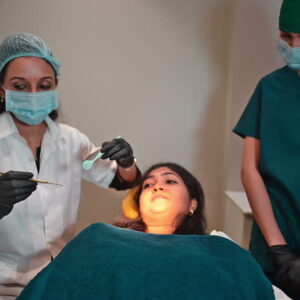Orthodontics is the treatment of malocclusion through orthodontic or surgical methods. Malocclusion refers to the deformity of teeth, jaws, and craniofacial factors caused by congenital or acquired factors during the growth and development of children. Malocclusion is listed as the three most common diseases of oral cavity together with dental caries and periodontal disease, and its prevalence rate is as high as more than 50% of the population.
steps/methods
- Metal brackets for orthodontics
The ordinary metal braces orthodontic technique is one of the most traditional and cheapest orthodontic techniques. The traditional orthodontic fixed appliance used in the ordinary metal bracket orthodontic technology is stainless steel bracket, which is widely used.
- Ceramic bracket
Compared with ordinary metal brackets, the most notable feature of ceramic bracket correction is its beauty. The colorless and transparent bracket perfectly realizes the concealment of the orthodontic process, and its good biocompatibility also avoids the dark tooth surface, gingival inflammation, oral ulcer, and other adverse reactions caused by long-term use of the bracket. Better for oral health.

- Invisible bracket
Invisible orthodontics, also known as “invisible brackets”, is a type of orthodontic treatment. Invisible bracket correction does not have the wires and brackets in the traditional orthodontic process, and it does not affect the appearance and other outstanding advantages and is widely favored by estheticians. This invisible orthodontic technology inherits the traditional concept of orthodontic treatment and is a perfect combination of modern stomatology, computer-aided three-dimensional diagnosis, personalized design, and digital molding technology.
- Self-locking bracket
The self-locking bracket appliance relies on a sliding or rotating bracket cover, bolt cover, or elastic clip to fix the archwire in the bracket groove, which is relative to the traditional ligation bracket. The self-locking bracket appliance is characterized by low friction, a short orthodontic treatment course, and good oral hygiene. There is no need for traditional stainless steel ligature wires or elastic rubber rings. The openable sliding cover on the bracket, the spring clip, or the elastic structure of the bracket itself is used to confine the orthopedic archwire in the groove of the bracket.
- Lingual bracket
Lingual invisible orthodontics has a history of more than 20 years. Lingual orthodontic technology is to bond brackets, archwires, etc. to the lingual surface of the teeth. The lip and buccal tooth surfaces are no different from ordinary people, and the components of the orthodontic appliance are basically invisible, so it does not hinder the patient’s daily life and social activities.
- Functional appliance
A functional appliance is also a kind of movable appliance, but it is different from the mechanical appliance, it does not produce any corrective force, its function is to change the function of the orofacial muscles, thereby promoting the normal growth and development of the maxillofacial region. Functional appliances include simple functional appliances, such as maxillary bevel guide and mandibular coronal bevel guide; functional regulators such as Frankel appliances and muscle stimulators.
Precautions
Avoid foods or drinks that are high in sugar, don’t bite food with your teeth, and cut fruit into small pieces and chew it in your mouth first.
Develop the habit of gargling after meals, brushing your teeth carefully, and doing good oral hygiene with interdental brushing.
After the braces treatment is completed, wearing a retainer is necessary, the retainer is made by a dentist or technician in a clinic or laboratory. The dental vacuum forming sheets are processed by dental vacuum former efficiently. It needs the soft or hard vacuum forming plastic sheets together with the dental vacuum former unit.







